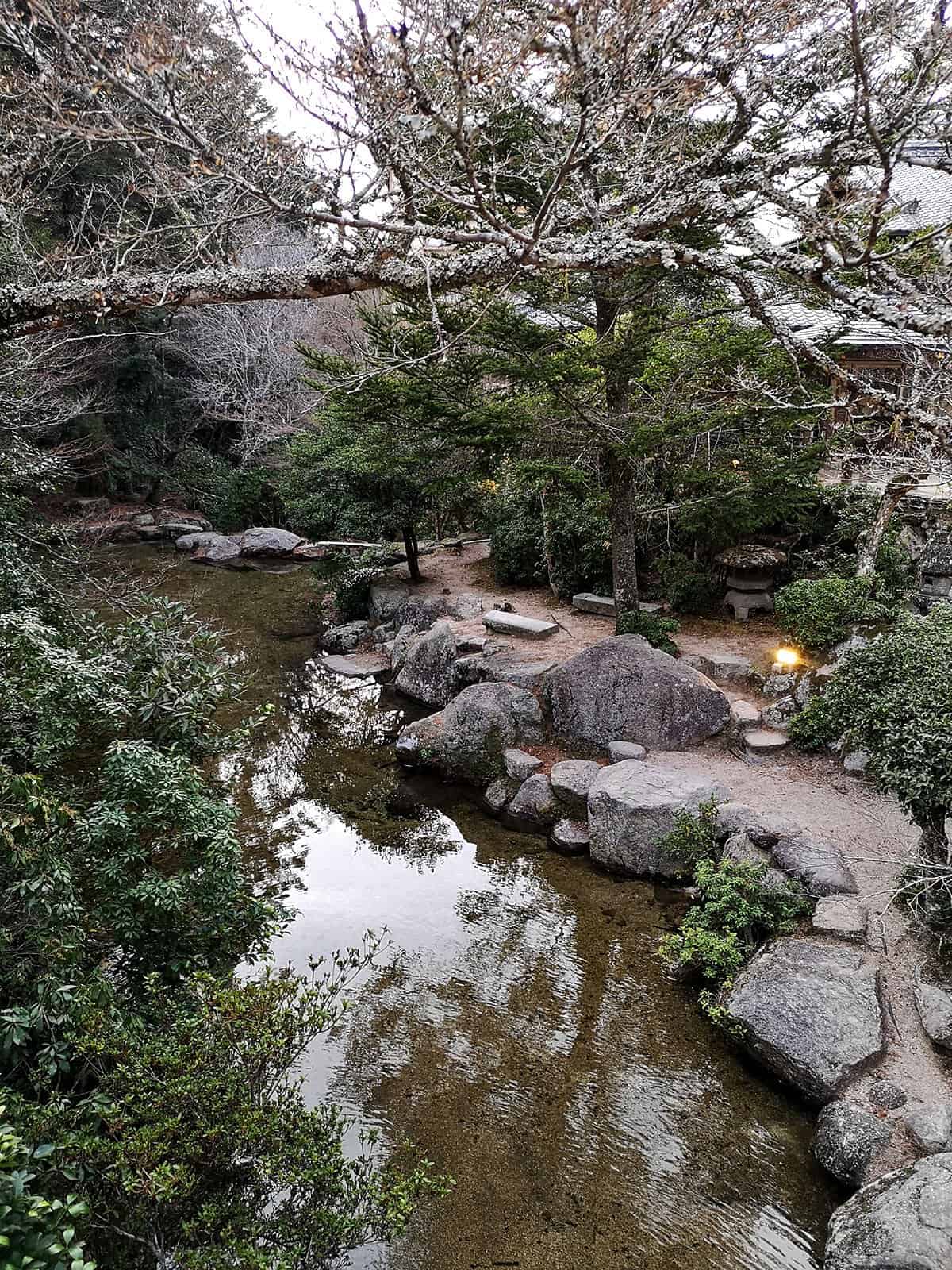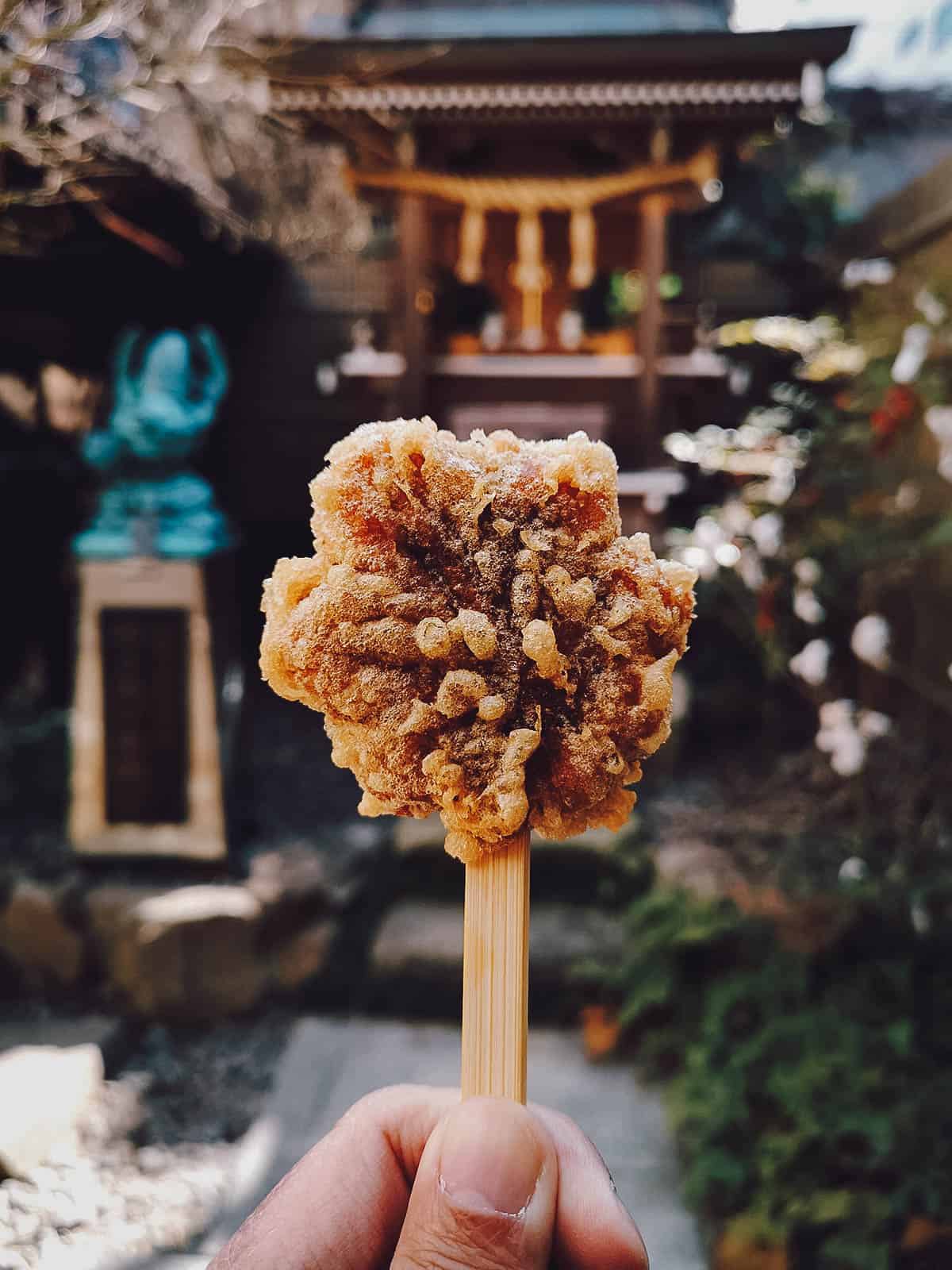SUMMARY HIGHLIGHTS
- Miyajima Island is lovely. You can easily visit on a day trip from Hiroshima, but if you have the time, then you may want to stay the night.
- The view of the floating torii gate at Itsukushima Shrine is considered one of Japan’s “three great scenic views”.
- The oysters in Miyajima are delicious.
Miyajima Island is famous for Itsukushima Shrine and its “floating” torii gate, one of the three most celebrated views in Japan.
I took a day trip from Hiroshima to visit the shrine only to find the torii gate completely covered in scaffolding. Little did I know, the famed floating gate had been undergoing a major renovation and wouldn’t be unveiled for at least a couple of years.
If that weren’t bad enough, I went to go ride the ropeway only to find that being serviced too. Winters are never too cold on Miyajima but it felt as if the island had gone into hibernation, with unlucky me picking the worst possible time to visit.
I wasn’t planning on hiking that day but the ropeway being out of commission forced me to do the two-hour trek to the summit of Mount Misen. We always want our trips to go as planned but what initially seemed like misfortune steered me to one of my best days ever in Japan.
A forested sanctuary revered as sacred since ancient times, I’ve read Miyajima described as “the island where God lives”. Away from the tourist crowds, with only the occasional deer to keep me company, it wasn’t hard to see why.
VISIT MIYAJIMA QUICK LINKS
For your convenience, I’ve compiled links to recommended hotels, tours, and other travel-related services here.
HOTELS
Top-rated hotels on Miyajima Island
EXPERIENCES
- Sightseeing Tour: Visit Miyajima and the G7 Hiroshima Summit Facilities
- Rickshaw Tour: Private Rickshaw Tour to Itsukushima Shrine
- Tea Ceremony: Cultural Experience in a Kimono
OTHER SERVICES
- Travel Insurance (non-US residents get 5% off)
- Visit Hiroshima Tourist Pass
- Japan Rail Pass
- Japan eSIM
GUIDE TABLE OF CONTENTS
MIYAJIMA AT A GLANCE
Miyajima is a small island less than an hour southwest of Hiroshima City. The island is officially named Itsukushima – after the shrine – though it’s more commonly referred to as Miyajima, Japanese for “shrine island”.
Miyajima Island is best known for Itsukushima Shrine’s iconic vermillion torii gate. Like the shrine’s main buildings, the gate is built over water and gives the impression of floating at sea during high tide.
For centuries, the shrine’s floating torii gate has been designated one of Japan’s three most scenic views. The other two are Amanohashidate in northern Kyoto and Matsushima Bay in Miyagi.
BEST TIME TO VISIT MIYAJIMA
Like Hiroshima City, Miyajima Island enjoys a temperate climate. My last trip was in the middle of winter and I was perfectly fine with just a puffer jacket, even while hiking on Mount Misen.
Miyajima Island is a year-round destination but like many places in Japan, spring and autumn are typically the best times to visit. Attractive clusters of cherry trees can be found around Tahoto Pagoda in spring while Momijidani Park is considered one of the most beautiful places in Japan for fall foliage.
TRAVELING TO MIYAJIMA FROM HIROSHIMA
Miyajima Island is an easy day trip from central Hiroshima. You can get there in less than an hour by train and ferry.
Using Google Maps, take a train or tram from your hotel to Miyajimaguchi Station. From there, it’s a short walk to the pier where you can catch a quick ferry ride to Miyajima. If you have an IC card, then you can use it for the ferry as well.
WHERE TO STAY IN MIYAJIMA
You can easily visit Miyajima on a day trip from Hiroshima, but after spending a few hours on the island, you may regret not spending the night. With its many ryokans, it’s an ideal place for an overnight stay.
You can find accommodations on Miyajima Island on Booking.com or Agoda. Listed below are some of the top-rated hotels on the island:
THINGS TO DO ON MIYAJIMA ISLAND
Located less than an hour from central Hiroshima, Miyajima Island is an easy day trip but if you’d like to explore the island with a guide, then you may be interested in this half-day Miyajima walking tour.
Enjoy One of Japan’s Most Scenic Views at Itsukushima Shrine
Itsukushima Shrine is the main reason why people visit Miyajima Island. It’s a Shinto shrine and UNESCO World Heritage Site renowned for its large torii gate that appears to float on water at high tide. When the water recedes, visitors can walk up to the gate and appreciate it from up close.
Like the torii gate, much of Itsukushima Shrine is built over water. It’s comprised of multiple buildings connected by boardwalks and supported by pillars over the sea.

Photo by cowardlion via Shutterstock
Take in The View From Senjokaku
When you visit Itsukushima Shrine, you’re sure to notice this beautiful five-storied pagoda resting atop a hill. It stands beside Senjokaku (aka Toyokuni Shrine or Hokoku Shrine), a large wooden hall originally built to be a Buddhist library.
Senjokaku is basically just a large open space without much to see or do, but it does offer fantastic views of Hiroshima Bay. It’s a great place to sit and enjoy a few quiet moments of reflection on Miyajima Island.

Make a Stop at Daishoin Temple
Located at the base of Mount Misen, Daishoin Temple is one of the most important temples of Shingon Buddhism. It consists of multiple buildings with numerous statues, religious items, and meditation halls.
Compared to Senjokaku, there’s a lot more to see at Daishoin Temple, like this cave with 88 statues representing the temples of the Shikoku Pilgrimage.
Daishoin Temple is located at the start of one of the hiking trails. You can spend a few moments here before trekking up to the summit of Mount Misen.

Go Hiking on Mount Misen
Hiking to the top of Mount Misen was my favorite thing to do on Miyajima Island. At 500 meters (1,640 ft) above sea level, it’s the highest point on Miyajima Island and offers spectacular views of Hiroshima Bay.
There are three hiking trails to the top of Mount Misen. Each will take between 1.5-2 hours to reach the summit. I took the easiest trail which gave me a decent workout, but if you’re relatively fit, then you shouldn’t have any problems trekking up the mountain. The scenery is beautiful and you’ll probably cross paths with the many wild deer on the island.

If you’d rather not walk the entire way up, then an alternative would be to take the Miyajima Ropeway. It’ll take you to the upper station at Shishi-iwa Observatory, about thirty minutes from the summit. Pictured below is the observation deck at the very top.

On my way down, I passed through Momijidani Park, one of the most famous places to view the autumn foliage in Japan. I went in winter when the trees were mostly bare but visitors in early to mid-November will be treated to the spectacular reds, oranges, and yellows of the fall season.
The park is located near Momojidani Station, the base station of the Miyajima Ropeway.

Feast on Hiroshima Bay’s Famous Oysters
Hiroshima is famous for its oysters. You can find them everywhere but the best are said to come from Miyajima Island. Oysters have been cultivated in Hiroshima Bay for nearly 500 years so it only makes sense that the freshest oysters can be found in Miyajima.
Oysters in Hiroshima are prepared in many ways. The oyster set below is comprised of deep-fried breaded oysters, grilled oysters, smoked oysters, oyster miso soup, pickled oysters, and kaki meshi (oyster rice). They’re delicious at any time of the year but especially in January and February when the oysters are at their most plump. Oishi!

Snack on Momiji Manju
Like momiji tempura in Minoo, Miyajima is known for its own maple leaf snack – momiji manju. It refers to a type of Japanese confection made with buckwheat and rice powder filled with a sweet paste.
Traditionally, momiji manju is filled with azuki paste but it can also be filled with other ingredients like custard, matcha, and chocolate. What you’re looking at here is a battered and deep-fried version served on a stick called age-momiji manju. Again, oishi!

Enjoy a Tea Ceremony
Visiting Miyajima on a day trip is great, but it’s even better when you stay overnight. It allows you to slow down, appreciate the island after the day trippers have gone, and enjoy less hurried activities like partaking in a tea ceremony.
They’re obviously made for tourists but Klook and Get Your Guide offer cultural experiences where guests can put on kimonos, learn calligraphy, and enjoy an informal tea ceremony with Japanese confections called wagashi.

VISIT MIYAJIMA FAQs
Is Miyajima Island worth visiting?
One hundred million percent YES. As I said, the day I spent on Miyajima Island has been one of my most memorable so far. The island is beautiful and offers so much more than just Itsukushima Shrine’s floating torii gate.
Do I need to be fit to hike up Mount Misen?
Not really, at least not for the easiest trail. I’m in decent shape, not an athlete by any stretch, and I didn’t have any trouble reaching the top. The hike did give me a good workout though. As long as you have a moderate level of fitness, then you should be fine.
I’m not sure how much more difficult the other trails are.
Should I spend the night on Miyajima Island?
Yes! You can see Miyajima’s highlights in a day but if you have the time, then it would be nice to stay the night – preferably at a ryokan – and enjoy the island in its quieter hours.
Like many popular day trip destinations, you’ll appreciate the island more after the tourists have gone (or before they arrive).
Can I feed the deer in Miyajima the way I can in Nara?
From what I’ve read, no you can’t. You shouldn’t give them any food as it can be detrimental to their well-being.
THE FINAL SAY
I enjoyed Hiroshima very much and a lot of that has to do with Miyajima. There’s something special about this island. It’s a rare feeling you can’t put into words but you’ll know it when you’re there.
Since the floating torii gate was a little shy last time, I’m already planning my return trip back. And next time, I’m staying overnight, preferably in the fall. I can’t wait.
Disclosure
This Miyajima travel guide contains affiliate links, meaning we’ll earn a small commission if you make a booking or purchase at no extra cost to you. As always, we only recommend products and services that we use ourselves and firmly believe in. We really appreciate your support as this helps us make more of these free travel guides. Arigato gozaimasu!
